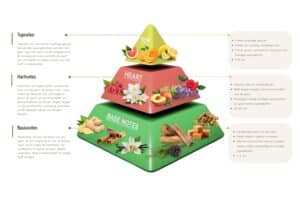When you smell a candle, perfume or even an essential oil, you are not only smelling something, you are interacting with the scent pyramid, a carefully designed sensory structure. This invisible blueprint allows a scent to turn from a momentary smell into a lasting memory.If you make candles or perfumes or just want to buy fragrance oils for your own projects, knowledge about the olfactory pyramid can help you choose and use scents. Let’s look at the science, structure and story behind each delicious scent.
What is the scent pyramid?
The scent pyramid, also known as a fragrance pyramid, is a model that shows how a fragrance changes over time after it is applied or diffused. It divides a fragrance into three layers: top notes, middle notes (heart notes) and base notes. Each layer has its own evaporation rate, intensity and function in the fragrance.
This model is not just for perfumers, but a universal guide to help anyone working with fragrance oils, such as candle makers, essential oil enthusiasts or product formulators, create scents that are balanced, memorable and long-lasting.
Top notes: the first impression
Top notes are the first thing you smell when you light a candle, put on perfume or use a blend of essential oils. Usually made up of small, light molecules that evaporate quickly, these notes are bright, fresh and energizing.
Top notes are meant to immediately grab your attention, making you want to know more about the fragrance and be drawn to it. They are short-lived, usually only 5 to 15 minutes, but they are very important to set the mood of a fragrance at the beginning.
Common categories of top notes:
- Citrus: bergamot, lemon, orange, grapefruit, lime, tangerine
- Green: basil, mint, green tea, tarragon, violet leaf, galbanum
- Aromatic: lavender, eucalyptus, sage, petitgrain
- Fruity (light): apple, pear, pineapple, berries, melon
- Spicy (fresh): cardamom, pink pepper, ginger
When choosing a fragrance oil for candles, the top notes help create the cold throw (the smell you smell before you light the candle), which is the first scent you catch. If you mix your own essential oils, a bright top note can add energy to your entire formula.
Middle notes: the heart of the fragrance
When the top notes fade, the middle notes, also called the “heart” of the fragrance, take over. These form the core of the fragrance and are usually rounder, softer and more complex than the first scent.
Middle notes emerge 15 to 30 minutes after application or lighting and usually linger for a few hours. They ensure that the lighter top notes and the deeper, heavier base notes blend well, so that the fragrance experience is smooth.
Common categories of middle notes:
- Floral: rose, jasmine, ylang-ylang, neroli, magnolia, tuberose, peony, violet, lily of the valley
- Fruity (soft/round): peach, apricot, plum, raspberry
- Spicy (hot): cinnamon, cloves, nutmeg, black pepper
- Spicy: rosemary, chamomile, marjoram
- Green/tea: mate, green tea, black tea
- Gourmand: honey, milk, almond
When you buy fragrance oils to make perfumes, soaps or body mists, the middle notes are very important because they help define the main personality of the product. In candles, they emerge when the wax begins to melt, which is when they give off the main scent while burning.
Base notes: the lasting impression
Base notes form the bottom of the fragrance pyramid. These molecules are heavier and evaporate more slowly, making a fragrance last longer and smell deeper. Base notes are often rich, soft and warm. They give a fragrance structure and balance, making it linger for hours or even days, especially in well-made candles or perfumes.
They do not emerge immediately, but build slowly, keeping the fragrance in place and supporting the more volatile top and middle notes. Base notes are the scents that linger in the room long after the candle is extinguished.
Common categories of base notes:
- Wood: sandalwood, cedarwood, vetiver, patchouli, guaiac wood, oud
- Resins and balms: benzoin, myrrh, frankincense, labdanum, tolu balsam
- Musk: white musk, animal musk (now synthetic)
- Amber accords: ambergris (synthetic), labdanum blends
- Sweet and gourmand: vanilla, tonka bean, caramel, chocolate
- Leather: suede, leather chords
- Earthy: oakmoss, hay, tobacco
A strong base note helps the fragrance last a long time and gives the scent its “memory” when using fragrance oils for candles. Base notes often have a grounding and healing effect in essential oil blends, making them great for calming blends or evening aromatherapy routines.
Why the fragrance pyramid is important when buying fragrance oils
It is essential to understand the fragrance pyramid if you want to buy fragrance oil for any purpose, whether for personal use, crafting or resale. Here’s why:
Blending: If you know how top, middle and base notes work together, you can create blends that are balanced and smell good.
Longevity: If you know which oils last longer, you can create scents that change over time.
Customization: You can create scents to suit your mood, the season or the type of product you want, such as fragrance oils for candles or skin-friendly blends of essential oils.
Fragrance oils versus essential oils: what’s the difference?
Many people use these terms interchangeably, but they do not mean the same thing.
Fragrance Oil
Fragrance oils are made to smell good and are fully synthetic or only partially synthetic. They can be used in many different ways, such as:
- Candles
- Soap
- Lotions
- Reed diffusers
They are ideal if you are looking for scents that are long-lasting and complex. YouWish has a wide range of fragrance oils for candles that are safe and work well when heated.
Essential oil
Essential oils are natural extracts of plants obtained through processes such as steam distillation. They are often used in natural products and aromatherapy.
Essential oils smell wonderful, but they can be more unstable and their strength can vary depending on where they come from. For safe use on the skin, they must also be diluted.
In short, use fragrance oils for candles and other crafts and save essential oils for therapeutic or all-natural uses.
Using the scent pyramid to create distinctive scents
Learning the pyramid model will make it much easier to create your own unique fragrance for candles, perfumes or diffusers. This is how you create your own fragrance:
Step 1: Choose your theme
Do you want a blend that soothes you? A floral love scent? A new fragrance that energizes you? Your theme will help you choose your fragrance notes.
Step 2: Choose notes from each layer
Top: Choose one or two new, happy notes.
Middle: Choose two or three fuller notes to shape the fragrance.
Base: Add 1 to 2 deep, anchoring notes to make the fragrance last longer.
Step 3: Mix and test
Start with small test amounts and adjust the ratios as needed. For example, a normal ratio is:
- 30% top notes
- 50% middle notes
- 20% base notes
This structure allows the fragrance to change nicely over time.
How the scent pyramid applies to candle making
Although how you use fragrance oil for candles is different from how you use it on your skin, the scent pyramid is still very important.
- Cold scent: usually shows the top notes.
- Warm scent: The candle burns and reveals the entire pyramid.
- After burning, the base note lingers in the room for hours.
If you know how this changes over time, you can choose the right fragrance oil for each phase to achieve the desired effect.
Tips for buying fragrance oil
If you are buying fragrance oils for the first time or want to expand your fragrance collection, keep these tips in mind:
Search for an overview of fragrance notes
Good suppliers will tell you whether the oil has floral top notes, musky base notes, and so on. YouWish gives you detailed descriptions of fragrances so you can make an informed choice.
Choose oils that fit the purpose
Choose scented candles that are clearly marked as suitable for high temperatures.
Choose body products oils that are safe for your skin.
For diffusers, choose ones that last a long time and diffuse cleanly.
Don’t forget to test
Each combination of wax, oil and wick works differently. Always test to find the best scent diffusion and burn profile.
Frequently asked questions about the fragrance pyramid and fragrance oils
V1. What is the difference between top, middle and base notes?
The top notes are light and do not linger long. The middle notes shape the fragrance and the base notes add depth and make the fragrance last long.
V2. Can I mix essential oils with fragrance oils?
Yes, but be careful. Essential oils are natural, but fragrance oils may contain synthetic chemicals that react differently when mixed.
V3. Is the scent pyramid important for candles?
Yes, definitely. The pyramid ensures the candle smells great from start to finish.
V4. Where can I buy high-quality fragrance oils?
YouWish has a collection of fragrance oils for you to view. Each oil is clearly labeled with the fragrance notes.
Final thoughts: control the pyramid, control the smell
The scent pyramid is more than just an idea; it is the secret behind creating scents that make people feel things and tell stories. You need to know how top, middle and base notes work together if you want to blend essential oils, choose fragrance oils for candles or start a fragrance brand.
Are you ready to create your perfect scent? Buy fragrance oils that work.Want to check out natural options? For a plant-based fragrance experience, check out our selection of essential oils.

